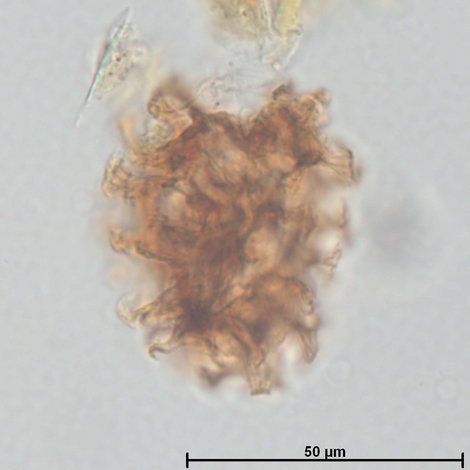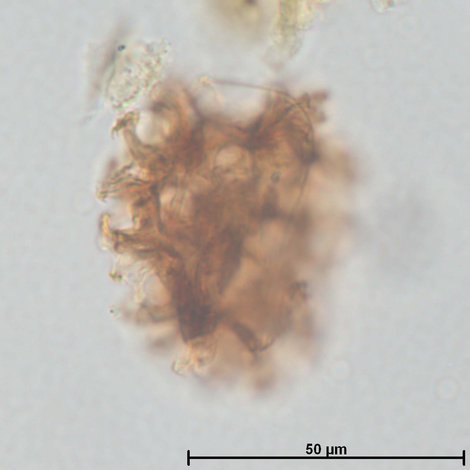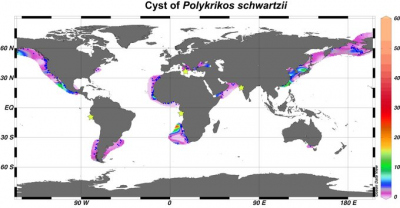Die Inhalte dieser Seite sind leider nicht auf Deutsch verfügbar.
Seitenpfad:
- Modern Dinocyst Key
- brown cysts
- brown elongate cysts
- cyst of Polykrikos schwartzii
cyst of Polykrikos schwartzii
Zonneveld, K.A.F. and Pospelova V. (2015). A determination key for modern dinoflagellate cysts. Palynology 39 (3), 387- 407.

lateral view
photo: Karin Zonneveld
locality: Adriatic Sea
photo: Karin Zonneveld
locality: Adriatic Sea

lateral view 2
photo: Karin Zonneveld
photo: Karin Zonneveld
Field Characteristics
Cyst of Polykrikos schwartzii (Bütschli 1873) Matsuoka 2009
Field characteristics:
Proximochorate cyst of elongate shape, medium to dark brown in colour. The cyst wall comprises of two or three layers, appressed between processes or shelf-like ornaments. The endophragm is smooth and relatively thin, and the periphragm is fibrous and coarsely wrinkled forming the complex processes or shelf-like ornaments, which are strongly fibrous. Basically five rows of separated processes or shelf-like ornaments transversely surround the cyst body. The morphology of these shelf-like ridges and processes is highly variable. In some cysts shelf-like ridges completely encircle the cyst body, however, other cysts with ridges are occasionally disconnected and undulate. These processes are hollow and are short cylindrical to infundibular with an opening at the distal ends. In some cysts, these ridges connect with others in different rows, forming an incomplete reticulate structure. Distal extremities of these fibrous ridges and processes are also variable, from patulate to recurved ends. The Archeopyle is apical, of tremic type, basically circular in shape with a slight zigzag margin and is formed at the polar region
Dimensions: Cyst body: 44 to 55 (width) x 60 to 782 (length) µm; length of processes: 8.5 to 14 µm.
Motile affinity: Polykrikos schwartzii
Cyst theca relationship: (Wall and dale 1968) Matsuoka 2009
Stratigraphic range: ?late Pleistocene to Recent.
Comparison with other species:
Cysts of P. schwartzii reflect the colonial character of the motiles by reflecting the cingulars of the individuals by rings of shelf-like ornaments. Generally five rings are present. Between these processes a reticulate pattern can develop. The pattern can be very irregular but generally the processes remain well visible. This in comparison to cysts of P. kofoidii that show a much more course reticulation where the processes are implemented.
Field characteristics:
Proximochorate cyst of elongate shape, medium to dark brown in colour. The cyst wall comprises of two or three layers, appressed between processes or shelf-like ornaments. The endophragm is smooth and relatively thin, and the periphragm is fibrous and coarsely wrinkled forming the complex processes or shelf-like ornaments, which are strongly fibrous. Basically five rows of separated processes or shelf-like ornaments transversely surround the cyst body. The morphology of these shelf-like ridges and processes is highly variable. In some cysts shelf-like ridges completely encircle the cyst body, however, other cysts with ridges are occasionally disconnected and undulate. These processes are hollow and are short cylindrical to infundibular with an opening at the distal ends. In some cysts, these ridges connect with others in different rows, forming an incomplete reticulate structure. Distal extremities of these fibrous ridges and processes are also variable, from patulate to recurved ends. The Archeopyle is apical, of tremic type, basically circular in shape with a slight zigzag margin and is formed at the polar region
Dimensions: Cyst body: 44 to 55 (width) x 60 to 782 (length) µm; length of processes: 8.5 to 14 µm.
Motile affinity: Polykrikos schwartzii
Cyst theca relationship: (Wall and dale 1968) Matsuoka 2009
Stratigraphic range: ?late Pleistocene to Recent.
Comparison with other species:
Cysts of P. schwartzii reflect the colonial character of the motiles by reflecting the cingulars of the individuals by rings of shelf-like ornaments. Generally five rings are present. Between these processes a reticulate pattern can develop. The pattern can be very irregular but generally the processes remain well visible. This in comparison to cysts of P. kofoidii that show a much more course reticulation where the processes are implemented.
Geographic Distribution
Geographic distribution based on :
Zonneveld et al., 2013. Atlas of modern dinoflagellate cyst distribution based on 2405 datapoints. Review of Palaeobotany and Palynology, v. 191, 1-197
Zonneveld et al., 2013. Atlas of modern dinoflagellate cyst distribution based on 2405 datapoints. Review of Palaeobotany and Palynology, v. 191, 1-197
Cysts of Polykrikos schwartzii typically occur in coastal temperate to equatorial environments. Only in the Pacific Ocean is occurs also in high latitudes. It can be abundant in regions with seasonally reduced salinities. it also occurs in but is not restricted to eutrophic areas and is not observed in regions where anoxic bottom waters occur.

Distribution:
Cysts of Polykrikos schwartzii are observed in coastal regions of the equatorial and sub-tropical north Atlantic, the Eastern Mediterranean Sea, Black Sea and Marmara Sea as well as the temperate South Atlantic, the sub-tropical Arabian Sea and the equatorial to sub-polar Pacific Ocean. It is not observed in the central parts of the oceans but can be very abundant in the vicinity of active upwelling cells for instance off NW Africa, the Benguela upwelling area off SW Africa and off central western America. Abundances >20% (up to 77%) occur in the tropical/equatorial parts off the Mexican coast (eastern equatorial Pacific), off NW Africa (eastern equatorial Atlantic), the Yellow Sea, East China Sea and Sea of Japan.
Environmental parameters:
SST: -1.6 - 29.4°C (winter - summer), SSS: 16.7 - 38.7 (summer - summer), [P]: 0.07 - 1.63 μmol/l,,[N]: 0.18 - 18.5 μmol/l, chlorophyll-a: 0.01 - 20.0 ml/l, bottom water [O2]: 0.8 - 8.2 ml/l.
Although the majority of the recordings are from full-marine settings, cysts of P. schwartzii can be observed in areas with reduced salinities occur during summer. The species can be very abundant in eutrophic environments but it is occasionally recorded from oligotrophic environments. Low cysts concentrations occur where phosphate concentrations are lowest. Cysts of Polykrikos schwartzii are not recorded from sites with anoxic bottom waters.
Comparison with other records:
Apart from the distribution recorded in this Atlas, cysts of Polykrikos schwartzii are observed along the western Indian margin, in the Congo discharge plume off western central Africa, the Peruvian upwelling area and off Sicily (Italy, central Mediterranean sea, Biebow et al., 1993; Dale et al., 2002; D'Costa et al., 2008; Rubino et al., 2010). Sediment trap studies show no seasonal pattern in the cyst production of Polykrikos schwartzii (Montresor et al., 1998; Zonneveld and Brummer, 2000; Fujii and Matsuoka, 2006; Price and Pospelova, 2011). In the Saanich Inlet (BC, Canada) enhanced cyst fluxes were registered when biogenic silica flux was enhanced (Price and Pospelova, 2011). In the western Arabian Sea off Somalia, cysts of Polykrikos schwartzii are observed in high abundances for the most coastal trap site only. There they reach extremely high numbers in sediments that had been transported from the shelf into the deeper ocean during a mass transport flux (Zonneveld and Brummer, 2000).
Polykrikos schwartzii is often observed in the tropics and subtropics. An exception is formed by the Pacific Ocean where it can be found in high latitudes as well. In the Pacific Arctic a positive correlation occurs between seasonal ice cover duration and the abundance of Polykrikos schwartzii cysts (Radi; and de Vernal, 2008). Radi and the Vernal (2008) note however that there are slight morphological differences between the cysts of Polykrikos schwartzii in the North Pacific and those in other parts of the world although this is not confirmed by Radi et al., (2007) and Pospelova et al. (2008) who observed cysts with a morphotype comparable to that of the Atlantic Ocean along the coast of British Columbia (Canada) and Washington State (USA) in the North Pacific. A species with a different morphology marked in previous literature as „Polykrikos cf. kofoidii“ can be observed in the warmer waters of the coastal eastern Pacific (Pospelova et al., 2008). This morphotype seems to be endemic for the Pacific Ocean. The above discussion documents that several „cryptic species“ have been included into the morphotype „cysts of Polykrikos schwartzii“ in this Atlas and future studies are needed to separate these forms on species level.
Polykrikos kofoidii/schwartzii are often characteristically present in highly polluted coastal waters and are thought to be typical for areas where human-induced eutrophication occurs (Matsuoka et al., 2003; Pospelova et al., 2002; Pospelova et al., 2004; Pospelova et al., 2005; Dale, 2009; Kim et al., 2009; Pospelova and Kim, 2010; Zonneveld et al., 2012). Unfortunately it is not always clear which of the two species (P. kofoidii or P. schwartzii) has been recorded or if they have been separated at all.
Cysts of Polykrikos schwartzii are observed in coastal regions of the equatorial and sub-tropical north Atlantic, the Eastern Mediterranean Sea, Black Sea and Marmara Sea as well as the temperate South Atlantic, the sub-tropical Arabian Sea and the equatorial to sub-polar Pacific Ocean. It is not observed in the central parts of the oceans but can be very abundant in the vicinity of active upwelling cells for instance off NW Africa, the Benguela upwelling area off SW Africa and off central western America. Abundances >20% (up to 77%) occur in the tropical/equatorial parts off the Mexican coast (eastern equatorial Pacific), off NW Africa (eastern equatorial Atlantic), the Yellow Sea, East China Sea and Sea of Japan.
Environmental parameters:
SST: -1.6 - 29.4°C (winter - summer), SSS: 16.7 - 38.7 (summer - summer), [P]: 0.07 - 1.63 μmol/l,,[N]: 0.18 - 18.5 μmol/l, chlorophyll-a: 0.01 - 20.0 ml/l, bottom water [O2]: 0.8 - 8.2 ml/l.
Although the majority of the recordings are from full-marine settings, cysts of P. schwartzii can be observed in areas with reduced salinities occur during summer. The species can be very abundant in eutrophic environments but it is occasionally recorded from oligotrophic environments. Low cysts concentrations occur where phosphate concentrations are lowest. Cysts of Polykrikos schwartzii are not recorded from sites with anoxic bottom waters.
Comparison with other records:
Apart from the distribution recorded in this Atlas, cysts of Polykrikos schwartzii are observed along the western Indian margin, in the Congo discharge plume off western central Africa, the Peruvian upwelling area and off Sicily (Italy, central Mediterranean sea, Biebow et al., 1993; Dale et al., 2002; D'Costa et al., 2008; Rubino et al., 2010). Sediment trap studies show no seasonal pattern in the cyst production of Polykrikos schwartzii (Montresor et al., 1998; Zonneveld and Brummer, 2000; Fujii and Matsuoka, 2006; Price and Pospelova, 2011). In the Saanich Inlet (BC, Canada) enhanced cyst fluxes were registered when biogenic silica flux was enhanced (Price and Pospelova, 2011). In the western Arabian Sea off Somalia, cysts of Polykrikos schwartzii are observed in high abundances for the most coastal trap site only. There they reach extremely high numbers in sediments that had been transported from the shelf into the deeper ocean during a mass transport flux (Zonneveld and Brummer, 2000).
Polykrikos schwartzii is often observed in the tropics and subtropics. An exception is formed by the Pacific Ocean where it can be found in high latitudes as well. In the Pacific Arctic a positive correlation occurs between seasonal ice cover duration and the abundance of Polykrikos schwartzii cysts (Radi; and de Vernal, 2008). Radi and the Vernal (2008) note however that there are slight morphological differences between the cysts of Polykrikos schwartzii in the North Pacific and those in other parts of the world although this is not confirmed by Radi et al., (2007) and Pospelova et al. (2008) who observed cysts with a morphotype comparable to that of the Atlantic Ocean along the coast of British Columbia (Canada) and Washington State (USA) in the North Pacific. A species with a different morphology marked in previous literature as „Polykrikos cf. kofoidii“ can be observed in the warmer waters of the coastal eastern Pacific (Pospelova et al., 2008). This morphotype seems to be endemic for the Pacific Ocean. The above discussion documents that several „cryptic species“ have been included into the morphotype „cysts of Polykrikos schwartzii“ in this Atlas and future studies are needed to separate these forms on species level.
Polykrikos kofoidii/schwartzii are often characteristically present in highly polluted coastal waters and are thought to be typical for areas where human-induced eutrophication occurs (Matsuoka et al., 2003; Pospelova et al., 2002; Pospelova et al., 2004; Pospelova et al., 2005; Dale, 2009; Kim et al., 2009; Pospelova and Kim, 2010; Zonneveld et al., 2012). Unfortunately it is not always clear which of the two species (P. kofoidii or P. schwartzii) has been recorded or if they have been separated at all.


